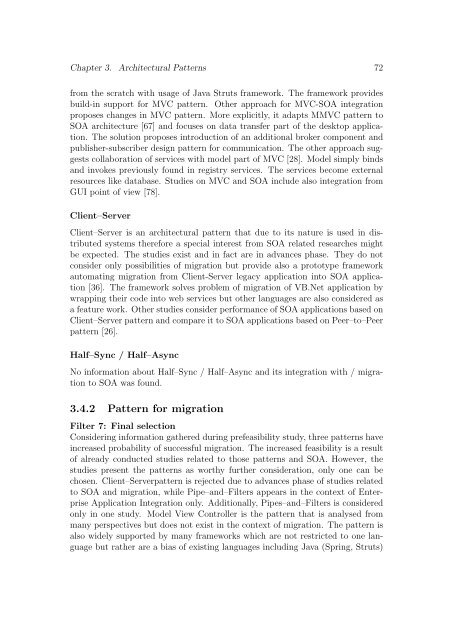Migration of a Chosen Architectural Pattern to Service Oriented ...
Migration of a Chosen Architectural Pattern to Service Oriented ...
Migration of a Chosen Architectural Pattern to Service Oriented ...
Create successful ePaper yourself
Turn your PDF publications into a flip-book with our unique Google optimized e-Paper software.
Chapter 3. <strong>Architectural</strong> <strong>Pattern</strong>s 72from the scratch with usage <strong>of</strong> Java Struts framework. The framework providesbuild-in support for MVC pattern. Other approach for MVC-SOA integrationproposes changes in MVC pattern. More explicitly, it adapts MMVC pattern <strong>to</strong>SOA architecture [67] and focuses on data transfer part <strong>of</strong> the desk<strong>to</strong>p application.The solution proposes introduction <strong>of</strong> an additional broker component andpublisher-subscriber design pattern for communication. The other approach suggestscollaboration <strong>of</strong> services with model part <strong>of</strong> MVC [28]. Model simply bindsand invokes previously found in registry services. The services become externalresources like database. Studies on MVC and SOA include also integration fromGUI point <strong>of</strong> view [78].Client–ServerClient–Server is an architectural pattern that due <strong>to</strong> its nature is used in distributedsystems therefore a special interest from SOA related researches mightbe expected. The studies exist and in fact are in advances phase. They do notconsider only possibilities <strong>of</strong> migration but provide also a pro<strong>to</strong>type frameworkau<strong>to</strong>mating migration from Client-Server legacy application in<strong>to</strong> SOA application[36]. The framework solves problem <strong>of</strong> migration <strong>of</strong> VB.Net application bywrapping their code in<strong>to</strong> web services but other languages are also considered asa feature work. Other studies consider performance <strong>of</strong> SOA applications based onClient–Server pattern and compare it <strong>to</strong> SOA applications based on Peer–<strong>to</strong>–Peerpattern [26].Half–Sync / Half–AsyncNo information about Half–Sync / Half–Async and its integration with / migration<strong>to</strong> SOA was found.3.4.2 <strong>Pattern</strong> for migrationFilter 7: Final selectionConsidering information gathered during prefeasibility study, three patterns haveincreased probability <strong>of</strong> successful migration. The increased feasibility is a result<strong>of</strong> already conducted studies related <strong>to</strong> those patterns and SOA. However, thestudies present the patterns as worthy further consideration, only one can bechosen. Client–Serverpattern is rejected due <strong>to</strong> advances phase <strong>of</strong> studies related<strong>to</strong> SOA and migration, while Pipe–and–Filters appears in the context <strong>of</strong> EnterpriseApplication Integration only. Additionally, Pipes–and–Filters is consideredonly in one study. Model View Controller is the pattern that is analysed frommany perspectives but does not exist in the context <strong>of</strong> migration. The pattern isalso widely supported by many frameworks which are not restricted <strong>to</strong> one languagebut rather are a bias <strong>of</strong> existing languages including Java (Spring, Struts)
















